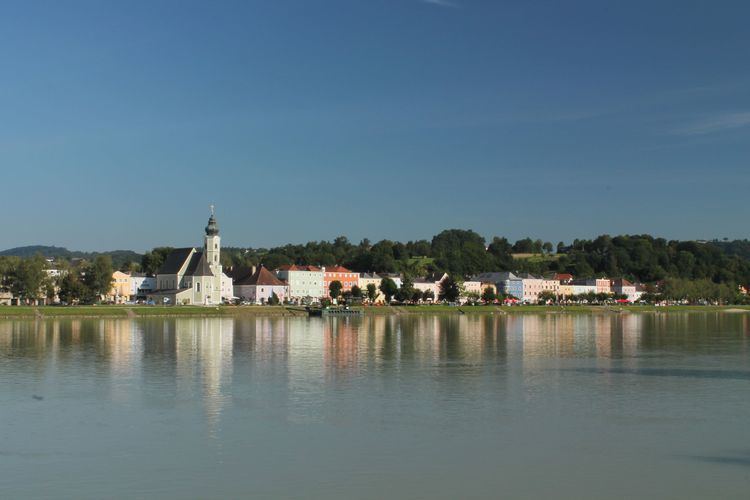Vehicle registration EF Elevation 268 m Population 2,201 (1 Apr 2009) Postal code 4082 | Time zone CET (UTC+1) Website www.aschach.at Area 6 km² Local time Sunday 11:53 AM Area code 07273 | |
 | ||
Weather 6°C, Wind W at 5 km/h, 62% Humidity | ||
Reisebericht aschach an der donau o mai 2014
Aschach an der Donau is a municipality in the district Eferding in the Austrian state of Upper Austria.
Contents
- Reisebericht aschach an der donau o mai 2014
- Map of Aschach an der Donau Austria
- Perchtenlauf aschach an der donau
- Geography
- Coat of arms
- History
- Celts and Romans in Aschach
- Municipal Council
- Mayor
- Sister City
- Landmarks
- Transport
- Education
- References
Map of Aschach an der Donau, Austria
Perchtenlauf aschach an der donau
Geography
Aschach lies in the Danube Valley, on the edge of the Eferding Basin in the Hausruckviertel. About 2 percent of the area is forested.
Subdivisions are: Aschach an der Donau (center), Ruprechting, and Sommerberg.
Coat of arms
Silver and red, covered by two natural colored, twisted grapevines with a blue grape to the left, a green grape to the right and a green leaf in each half.
The colors of the banner are red, white and green. The motif indicates due to climatic advantages in the early Middle Ages operated winery, which was mentioned in the Stiftbrief for Kremsmünster in the year 777 and was maintained in the area around Aschach in some vineyards until after 1870. White-red are the colors of the banner of arms of the Counts of Schauberg, who until 1559 held government and a major toll in Aschach.
History
First mentioned in the year 777 at the founding of the monastery Kremsmünster, Aschach was originally part of the eastern part of the Duchy of Bavaria and belonged to the Duchy of Austria up to the 12th Century.
1490 Aschach was attributed to the Principality of Österreich ob der Enns, and received the market rights and Coat of arms in 1512 by Emperor Maximilian. During the Napoleonic wars the town was occupied several times. Since 1918, the town belongs to the state of Upper Austria. After the annexation of Austria to the German Reich March 13, 1938 the town belonged to Gau Oberdonau. After 1945 followed the restoration of Upper Austria.
Celts and Romans in Aschach
The Celtic name Joviacum appeared first on the Itinerarium Antoninianum at the time when the Roman Emperor Marcus Aurelius Antoninus, nicknamed Caracalla, reigned from 211-217.
1838 during excavations in Schlögen extensive wall remains of a Roman fort were found. Therefore, by the middle of this century it was assumed that Schlögen was Joviacum as referred to in the Directory of Roman legions. After excavations in the years 1957-1959 by Dr. Lothar Eckhart proved: Schlögen cannot be Joviacum. Eckhart associates the Militum Liburnariorum, a sort of Marines of the Italian Legion, with Aschach, the mounted military units Ad Mauros with Eferding. Other than strategic reasons speak for that Aschach is Joviacum the St. Laurentius-patronage of the chapel at the cemetery, the evidence of a Roman square floor plan and the finding of street pavement stones and cart ruts (Limes road?) In the Abelstraße.
Since Aschach is Joviacum, this brings us into the closest connection with the most amazing sources of departing Antiquity with the "Life of St. Serverin" of the abbot Eugippius. St. Severin appeared in Noricum, a time when the Roman rule came to an end. As a monk and miracle worker, he resisted the Germanic princes, who were sitting with their tribes on both sides of the Danube. In the deserted Roman settlements, he persuaded the defenseless poor Roman people to a Christian lifestyle. When the circumstances had become untenable, he predicted them the imminent defeat of their place and ordered the evacuation of the area. So also for Aschach (Joviacum). We read in the Vita Sancti Severini Eugippii:
"... the servant of God sent the church singer Moderatus to the inhabitants of a city called Joviacum which was more than 20 miles away from Batavis, who should ask there an immediate escape from the vulnerable city. Also here the well-meant advice was not heard so that the saint sent off a courier again, who should at least prompt the church leader Maximianus of Joviacum to leave the village. When also this messenger was not believed, he left the city quickly. Still in the same night the Heruli invaded Joviacum, destroyed the settlement and led most of the inhabitants into slavery. The priest they hung on the gallows."
The details of the Vita is deemed reliable, earlier doubts are resolved by more recent research. Thus, under stipulation of the assumption of the accuracy that Aschach is Joviacum it is testified that the Late Antiquity martyr is MAXIMIANUS of Aschach.
Municipal Council
The following parties are represented in the council:
Mayor
Incumbent Mayor is Friedrich Knierzinger (ÖVP).
Sister City
Landmarks
Transport
In addition to the Danube, the main traffic route for thousands of years, in 1886 Aschach was connected by the Aschacher Bahn (Aschach - Eferding - Wels) to the modern transportation system.
During the power plant construction the railway was extended through Aschach to the power plant (then dismantled).
In 1962 the ferry ("Flying Bridge") was replaced by the bridge farther down the river and thus the region Mühlviertel and the central region connected to one another.
Bus lines operate scheduled bus service between neighboring cities among which are Wels, Linz, and Passau in Bavaria.
